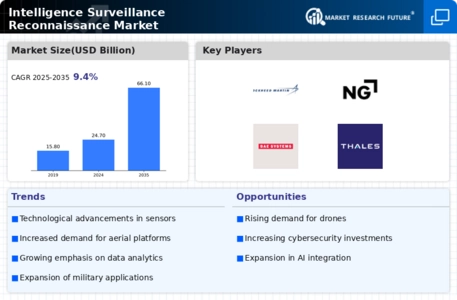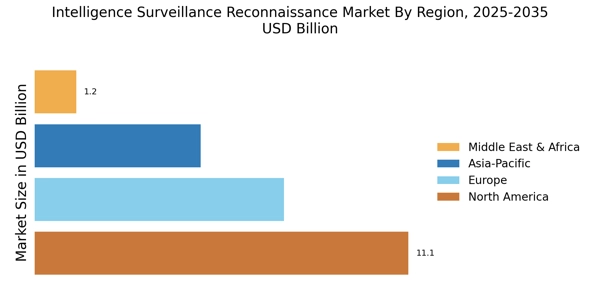North America : Defense Innovation Leader
North America is the largest market for Intelligence Surveillance Reconnaissance (ISR) technologies, holding approximately 45% of the global market share. The region's growth is driven by increasing defense budgets, technological advancements, and a focus on national security. Regulatory support from government agencies, including the Department of Defense, further catalyzes market expansion, emphasizing the need for advanced ISR capabilities to address emerging threats. The United States stands as the leading country in this sector, with major players like Northrop Grumman, Lockheed Martin, and Raytheon Technologies dominating the landscape. The competitive environment is characterized by continuous innovation and collaboration with government entities. Canada also plays a significant role, contributing to the North American market with its own defense initiatives and partnerships with U.S. firms.
Europe : Growing Defense Collaboration
Europe is witnessing a significant increase in demand for ISR technologies, holding approximately 30% of the global market share. The region's growth is fueled by collaborative defense initiatives among EU member states and a heightened focus on border security and counter-terrorism. Regulatory frameworks, such as the European Defence Fund, are pivotal in promoting research and development in ISR capabilities, ensuring that European nations can effectively respond to security challenges. Leading countries in Europe include the United Kingdom, France, and Germany, where companies like BAE Systems, Thales Group, and Airbus are key players. The competitive landscape is marked by strategic partnerships and joint ventures aimed at enhancing technological capabilities. The presence of established defense contractors and a growing emphasis on innovation position Europe as a formidable player in the ISR market.
Asia-Pacific : Emerging Market Potential
Asia-Pacific is emerging as a significant player in the ISR market, accounting for approximately 20% of the global share. The region's growth is driven by increasing military expenditures, geopolitical tensions, and the need for enhanced surveillance capabilities. Countries are investing in advanced technologies to modernize their defense systems, supported by government initiatives aimed at strengthening national security and regional stability. Key players in this region include countries like India, Japan, and Australia, with companies such as Elbit Systems and L3Harris Technologies making notable contributions. The competitive landscape is evolving, with a focus on indigenous development and international collaborations. As nations prioritize ISR capabilities, the market is expected to witness substantial growth in the coming years, driven by both defense and commercial applications.
Middle East and Africa : Strategic Defense Investments
The Middle East and Africa region is experiencing a growing demand for ISR technologies, holding approximately 5% of the global market share. This growth is primarily driven by regional conflicts, terrorism threats, and the need for enhanced border security. Governments are increasingly investing in advanced ISR systems to bolster their defense capabilities, supported by international partnerships and arms procurement programs aimed at modernizing military forces. Countries like the United Arab Emirates, Saudi Arabia, and South Africa are leading the charge in adopting ISR technologies. The competitive landscape features both local and international players, with firms like Leonardo S.p.A. and Thales Group actively participating in the market. As defense budgets increase and security concerns rise, the ISR market in this region is poised for significant growth, reflecting a broader trend towards modernization and technological advancement.


















Leave a Comment